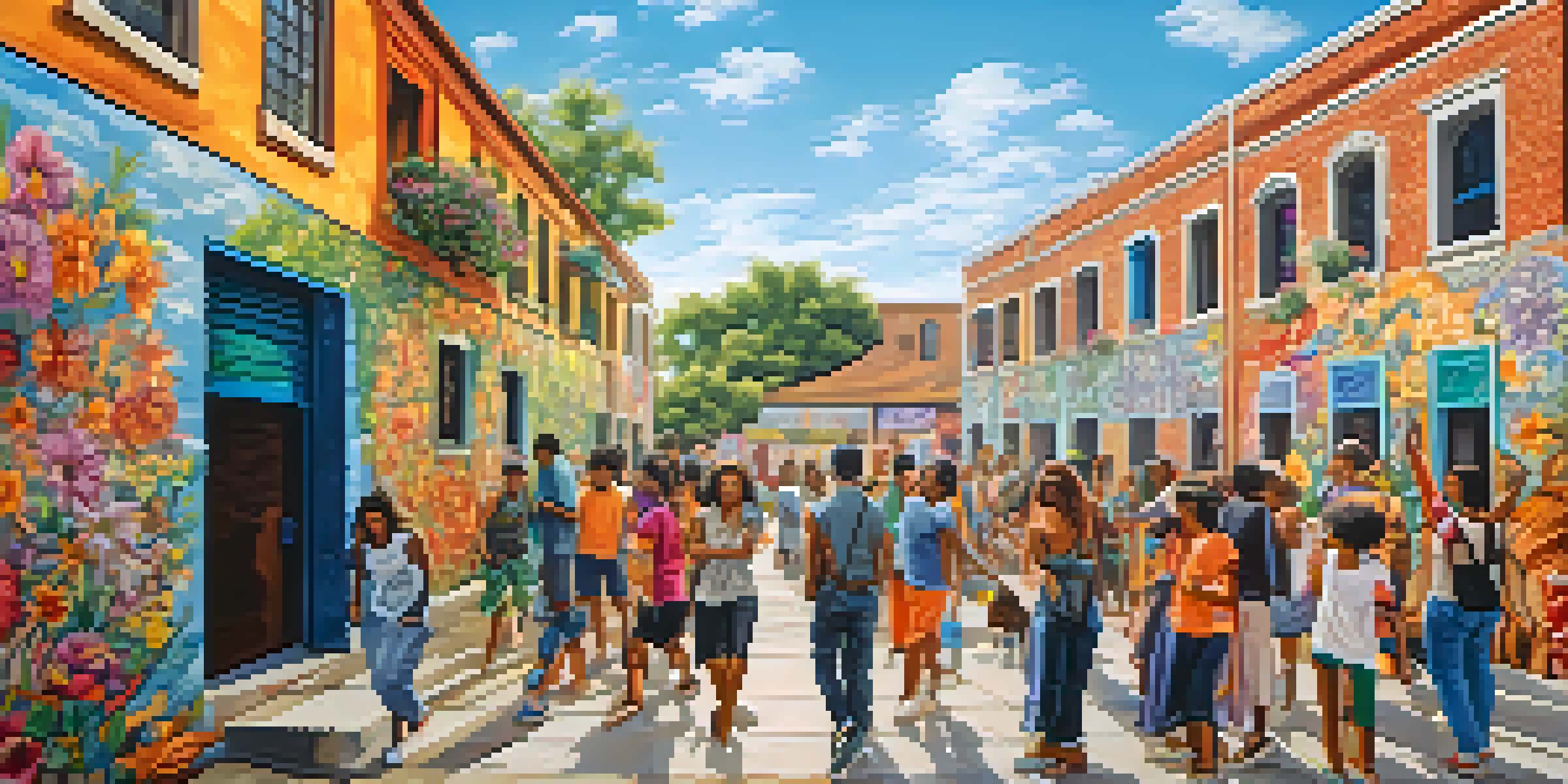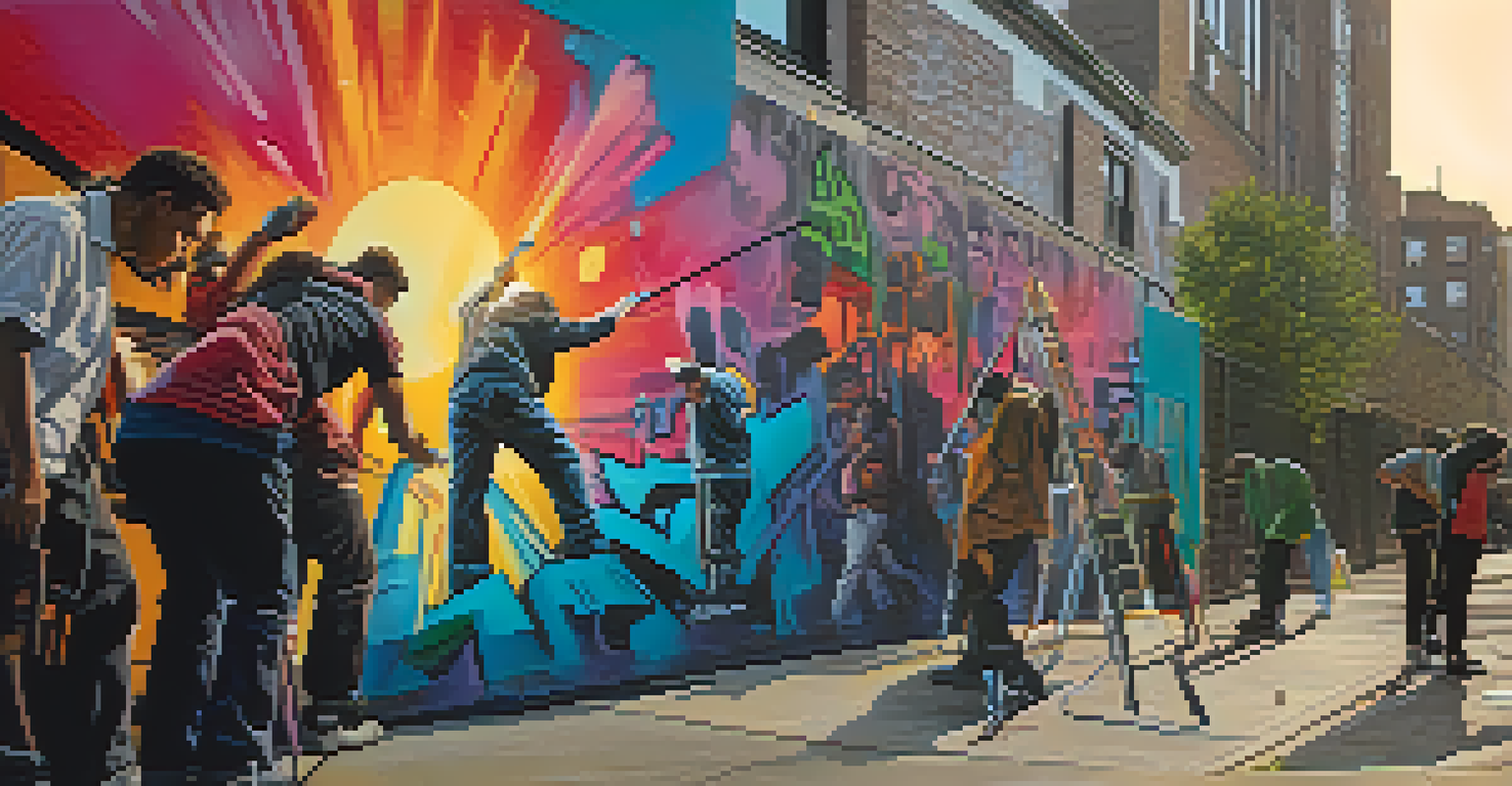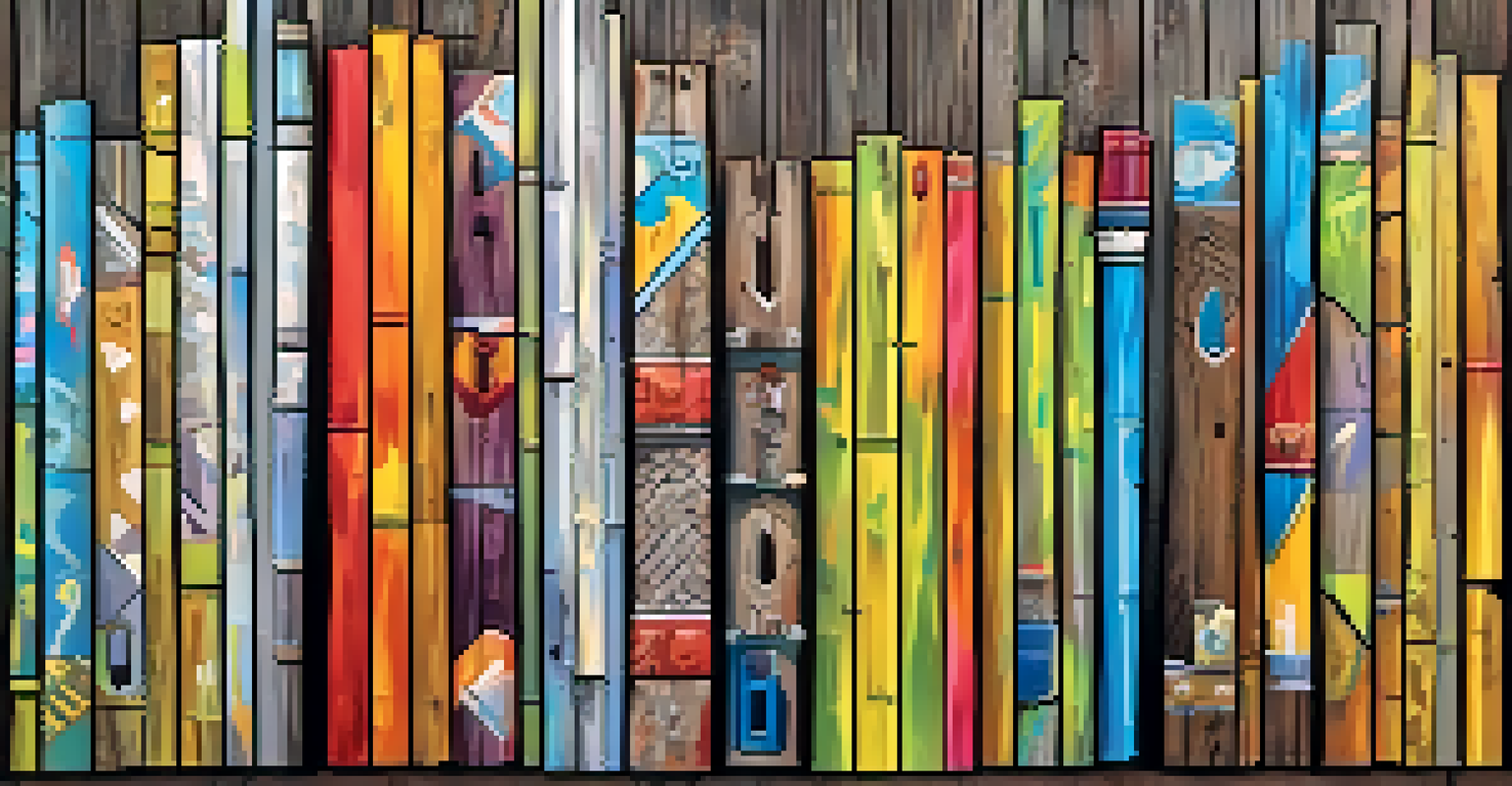Understanding the Differences Between Street Art and Graffiti

Defining Street Art: A Creative Expression
Street art is a form of visual art created in public spaces, often showcasing an artist's unique style. Unlike traditional forms of art, street art aims to engage with the community and provoke thought among viewers. It can range from murals and stencils to more intricate installations, often with a social or political message.
Art is not what you see, but what you make others see.
Artists like Banksy and Shepard Fairey have brought street art into the mainstream, making it a respected form of expression. The creativity involved often transforms urban environments, turning dull walls into vibrant canvases that invite interaction. This artistic approach encourages a dialogue between the artist and the audience, making it a dynamic part of public life.
While street art is often commissioned or created with permission, it still functions outside conventional gallery spaces. This location choice adds to its rebellious charm, inviting spontaneous encounters with art. Ultimately, street art plays a significant role in urban culture, redefining how we perceive public spaces.
Understanding Graffiti: A Subculture's Voice
Graffiti, on the other hand, is typically associated with tagging and is often viewed as vandalism. It involves writing or painting on surfaces without permission, primarily to mark territory or express identity. This often leads to a negative stigma, overshadowing the artistic skill involved in graffiti work.

Many graffiti artists use pseudonyms or 'tags' to establish their presence in the urban landscape, creating a sense of community among them. This practice can be seen as a rebellion against societal norms, where the streets become their canvas. While it may not always carry a social message like street art, it can still reflect personal stories and cultural commentary.
Street Art vs. Graffiti Insights
Understanding the differences between street art and graffiti highlights their unique intents and public perceptions.
Despite its controversial reputation, graffiti has evolved into a recognized art form, with some pieces fetching significant prices at auctions. Artists such as Jean-Michel Basquiat began their careers in graffiti, proving that this subculture can lead to mainstream success. Understanding graffiti requires looking beyond the surface and appreciating its role as a voice for marginalized communities.
Key Differences: Intent and Presentation
One of the main differences between street art and graffiti lies in their intent. Street art is often created with the intention of beautifying a space or conveying a message, while graffiti frequently serves as a means of self-expression through tagging. This distinction affects how each form is perceived by the public.
Graffiti is one of the few tools you have if you're a marginalized individual. It's a way to communicate, it's a way to connect.
In terms of presentation, street art tends to be more polished and detailed, often involving significant planning and execution. Conversely, graffiti can appear more spontaneous, with quick, bold strokes that emphasize the thrill of the act. This difference in style further separates the two forms, impacting their reception within the community.
Both art forms contribute to the urban landscape but do so in different ways. Street art may invite admiration and contemplation, whereas graffiti often challenges viewers to confront the rawness of the artist's experience. Understanding these differences helps us appreciate the diverse ways people express themselves in public spaces.
Public Perception: Art vs. Vandalism
Public perception plays a crucial role in how street art and graffiti are valued. Street art is often celebrated for its creativity and ability to transform spaces, leading to community support and even funding for projects. Many cities have embraced street art as a way to enhance their cultural identity and attract tourism.
In contrast, graffiti is frequently labeled as vandalism, leading to legal repercussions for those who engage in it. This perception often stems from the association of graffiti with crime and disorder, overshadowing the skill and artistry involved. As a result, graffiti artists may work in secrecy, which can add to the allure but also to the misunderstanding of their work.
Cultural Stories Through Art
Both street art and graffiti serve as powerful storytelling tools that reflect the culture and issues of their communities.
Despite the stigma, there is a growing movement to recognize graffiti as a legitimate art form. Some cities have begun to designate spaces for graffiti, allowing artists to create legally while still engaging with their craft. This shift in perception highlights the evolving relationship between urban communities and these two forms of expression.
Cultural Impact: Storytelling Through Art
Both street art and graffiti serve as powerful storytelling tools, reflecting the culture and issues of the communities where they exist. Street artists often tackle themes such as social justice, environmental issues, and local histories, using their art to educate and inspire. This narrative aspect of street art fosters a deeper connection with viewers, as they can see their own experiences reflected in the artwork.
Graffiti, while often perceived as rebellious, also tells stories of identity, struggle, and resistance. Many graffiti pieces incorporate personal narratives or cultural references, giving voice to those who feel marginalized. This ability to communicate through visuals allows both street art and graffiti to transcend language barriers, making them accessible to a diverse audience.
By exploring these narratives, we can appreciate how each form contributes to the cultural fabric of society. Street art and graffiti not only beautify urban spaces but also provoke thought and inspire action. Ultimately, they remind us of the power of art to communicate and connect.
Legality and Ethics: Navigating the Gray Areas
The legality of street art and graffiti often leads to complex discussions about ethics and ownership. While street art can be commissioned and celebrated, graffiti typically involves trespassing and vandalism laws. This legal distinction creates a gray area where the intentions of the artist may conflict with societal rules, leading to debates about what constitutes 'acceptable' art.
Many street artists seek permission from property owners, ensuring their work is seen as a legitimate contribution to the community. However, this approach can also lead to conflicts with those who view public spaces as areas for expression without restrictions. As a result, the dialogue around legality becomes an essential part of understanding both street art and graffiti.
The Evolving Landscape of Urban Art
The future of urban art is characterized by blending styles, fostering greater acceptance, and promoting collaboration between street artists and graffiti creators.
Ethically, artists must consider the impact of their work on the community and the environment. Balancing personal expression with respect for public spaces is crucial, fostering a dialogue between artists and their surroundings. As the conversation around urban art continues to evolve, so too will our understanding of these complex issues.
The Future of Urban Art: Blending Styles
As urban art continues to evolve, we're witnessing a fascinating blending of styles between street art and graffiti. Many artists draw inspiration from both forms, creating hybrid pieces that incorporate the spontaneity of graffiti with the planned execution of street art. This fusion opens new avenues for creativity and expression, pushing the boundaries of what urban art can be.
Cities around the world are beginning to recognize the value of supporting diverse art forms. Initiatives that promote public art projects often include both street art and graffiti, allowing artists to collaborate and share their visions. This inclusive approach not only enriches the urban landscape but also fosters a sense of community among artists and residents alike.

Looking ahead, the future of urban art is likely to be characterized by greater acceptance and integration of these two forms. As society continues to engage with issues of identity, culture, and expression, street art and graffiti will remain vital channels for communication. Embracing this evolution helps us appreciate the richness of urban art as a dynamic and transformative force.